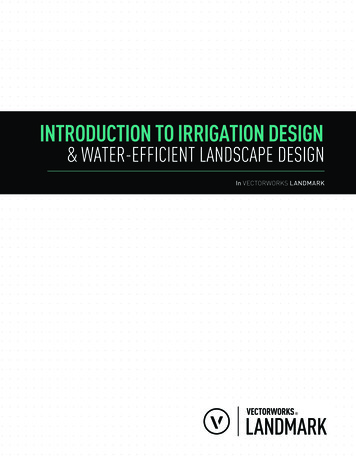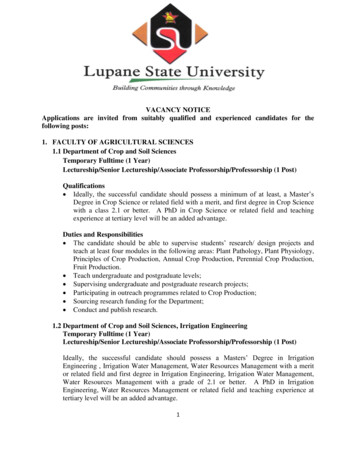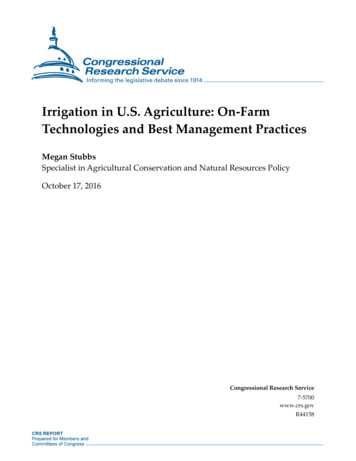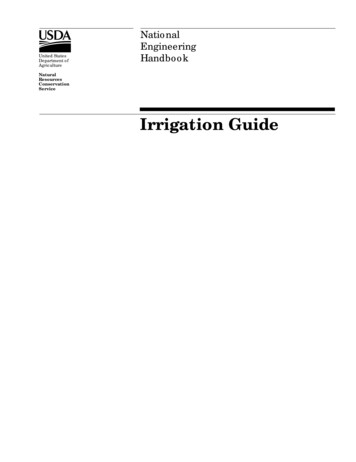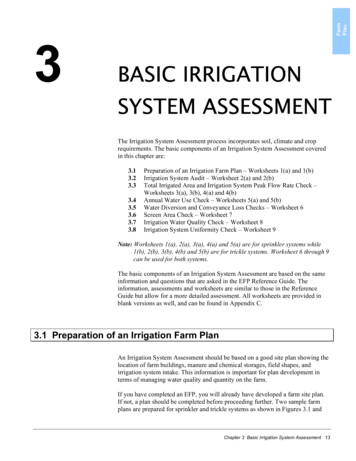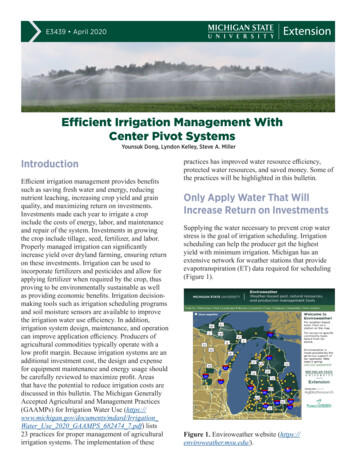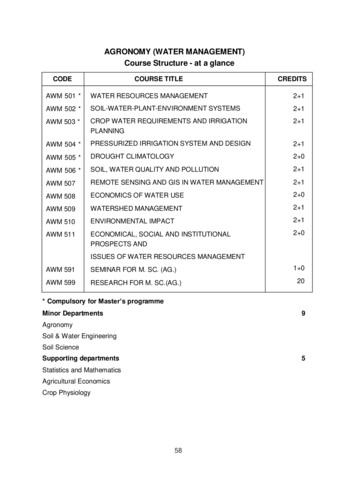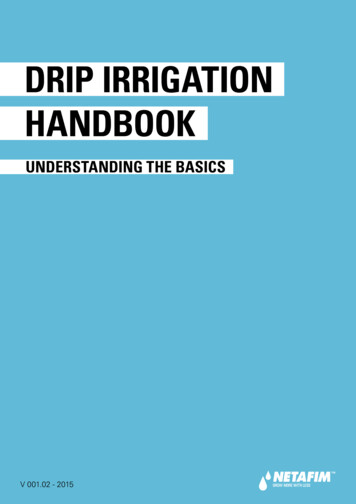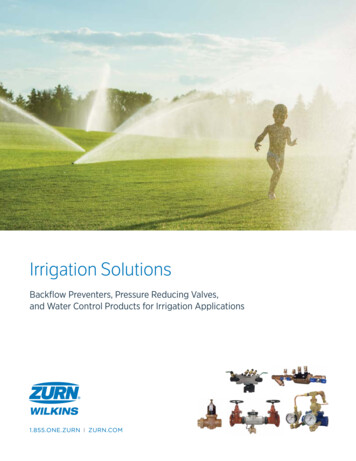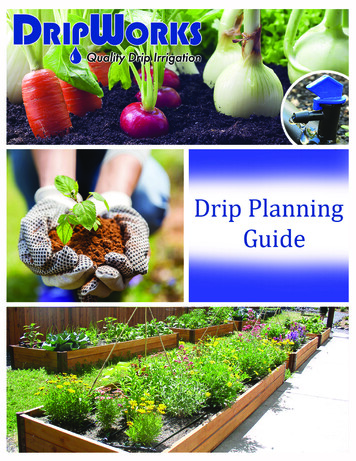
Transcription
Irrigation Reference ManualA technical reference to be used with the Peace CorpsIrrigation Training Manual in the selection, planning,design, operation, and management of small-scaleirrigation systemsPrepared for the Peace CorpsbyAgro Engineering, Inc.0210 Road 2 SouthAlamosa, Colorado 81101Authors:LeRoy SalazarJim TolisanoKeith CraneLee WheelerMaya ter KuileDavid RadtkePeace CorpsInformation Collection and ExchangeTraining Manual T0077September 1994INFORMATION COLLECTION & EXCHANGEPeace Corps' Information Collection & Exchange (ICE) was established so that thestrategies and technologies developed by Peace Corps Volunteers, their co-workers, andtheir counterparts could be made available to the wide range of developmentorganizations and individual workers who might find them useful. Training guides,curricula, lesson plans, project reports, manuals and other Peace Corps-generatedmaterials developed in the field are collected and reviewed. Some are reprinted "as is";others provide a source of field based information for the production of manuals or forresearch in particular program areas. Materials that you submit to the InformationCollection & Exchange thus become part of the Peace Corps' larger contribution todevelopment.Information about ICE publications and services is available through:Peace CorpsInformation Collection & Exchange1111 - 20th Street, NWWashington, DC 20526USA
Website: http://www.peacecorps.govTelephone : 1-202-692-2640Fax : 1-202- 692-2641Add your experience to the ICE Resource Center. Send materials that you've prepared sothat we can share them with others working in the development field. Your technicalinsights serve as the basis for the generation of ICE manuals, reprints and resourcepackets, and also ensure that ICE is providing the most updated, innovative problemsolving techniques and information available to you and your fellow developmentworkers.This manual may be reproduced and/or translated in part or in full without payment orroyalty. Please give standard acknowledgment.ContentsChapter 1 - Introduction1.1 The role and purpose of irrigation1.2 Introduction to the irrigation reference manualChapter 2 - Physical and biological resource base2.1 Watersheds2.1.1 Watershed hydrology2.1.2 Hydrologic processes2.1.3 Assessing watershed conditions2.1.4 Soil and water conservation practices2.2 Water flow measurement2.2.1 Units of measurement2.2.2 Measuring devices in open channels2.2.3 Float method2.2.4 Weirs2.2.5 Siphon tubes2.2.6 Bucket and stopwatch method2.2.7 Orifices2.3 Surveying2.3.1 Profiling2.3.2 Steps in making a topographic man2.3.3 Abney level surveying2.3.4 Simple levels for use in surveying contour lines2.3.5 Compass use2.4 Soil-Plant-Water relationships2.4.1 Soil moisture storage and availability2.4.2 Estimating soil water characteristics on site2.4.3 Development of the soil water reservoir
2.4.4 Soil water availability and crop use patterns2.4.5 Soil intake characteristics2.4.6 Soil chemistry and fertility2.5 Conducting initial environmental evaluations of irrigation projects2.5.1 The role of environmental assessment2.5.2 Illustrative environmental review form for irrigation or water resourcedevelopment projectsChapter 3 - Developing water sources3.1 Diversions3.1.1 Types3.1.2 Types of construction materials3.1.3 Construction and maintenance factors3.2 Concrete3.2.1 Hand mixing3.3 Designing structures for springs and seeps3.3.1 Spring box designs3.4 Ponds for irrigation water storage3.4.1 Location of the pond3.4.2 Availability of water3.4.3 Soils3.4.4 Topography3.4.5 Design end construction3.5 Pumps and water lifting devices3.5.1 Types of pumps3.5.2 Pumps powered by humans and animals3.5.3 Animal-powered pumps3.5.4 Mechanically driven pumps3.5.5 Centrifugal pumps3.5.6 Propeller or axial flow pumps3.5.7 Mixed flow pumps3.5.8 Turbine pumps3.5.9 Sources of power3.5.10 Selection of pumps and power units3.5.11 Amount of water to be pumped3.5.12 The pumping lift or head3.5.13 Horsepower and efficiency3.5.14 Pump characteristic curves3.5.15 Power source and power Costs3.5.16 Pump location3.5.17 Pump installation3.5.18 Turbine and propeller pumps3.5.19 Intake structures3.5.20 Minimum water level
3.5.21 Typical pump design3.5.22 Size of pumps3.5.23 Costs3.5.24 Evaluation of pumping plants3.5.25 Rower puma3.5.26 Hydraulic ram3.6 Wells3.6.1. Methods of drilling: Percussion drilling3.6.2 Methods of drilling: Hand auger rig3.6.3 Other drilling equipment3.6.4 Hand dug wellsChapter 4 - Estimating irrigation requirements4.1 Introduction4.2 Reference crop evapotranspiration (ETo)4.3 FAO crop coefficients4.4 Dependable precipitation4.5 Effective precipitation4.6 Ground water contributions to crop requirements4.7 Gross irrigation requirementsChapter 5 - Farm water delivery systems5.1 Control of irrigation water5.1.1 Components of farm irrigation systems5.1.2 Open channel systems5.1.3 Control structures5.2 Pipeline hydraulics and design5.2.1 Continuity equation5.2.2 Pressure, head, and friction losses5.2.3 Factors influencing head loss5.2.4 Pine design5.2.5 The hydraulic gradient line (HGL)5.2.6 Pipeline design sample problems5.2.7 Pipes and pipeworking5.2.8 Working with pipes5.2.9 Water hammer5.2.10 Air relief. Vacuum relief, and pressure relief5.2.11 Other pipeline structures and accessories5.2.12 Pipeline materials5.3 Land leveling5.4 Irrigation methods5.4.1 Characteristics of irrigation systems5.5 Surface irrigation systems5.5.1 Criteria for design and operation5.5.2 Description of different surface irrigation methods
5.5.3 Contour ditch5.5.4 Contour levee5.5.5 Furrow irrigation5.5.6 Corrugation irrigation5.5.7 Operation and maintenance of farm surface irrigation systems5.6 Sprinkler irrigation systems5.6.1 Principal components5.6.2 Pine specifications5.6.3 Sprinkler heads and nozzles5.6.4 Sprinkler system design5.6.5 Lateral design5.6.6 Sprinkler system installation5.6.7 System operation and maintenance5.7 Localized irrigation systems5.7.1 Characteristics5.7.2 Operation and maintenanceChapter 6 - Farm water management6.1 Farm water management6.1.1 General concepts6.2 Farm irrigation scheduling6.2.1 Factors affecting irrigation scheduling6.2.2 The practice of irrigation scheduling6.2.3 Techniques for preparing irrigation schedules6.2.4 Useful relationships in irrigation scheduling6.2.5 The soil water budget approach6.2.6 The feel and appearance method6.2.7 Summary of scheduling techniques6.2.8 A comparison of scheduling criteria for surface, sprinkler, and drip irrigation6.2.9 Rice irrigation scheduling6.2.10 Scheduling and management strategies for limited water supplies6.2.11 Delivery system schedules6.2.12 Project scheduling a summary6.3 Evaluation of existing irrigation systems6.3.1 Strategies for farm management6.3.2 Rapid on-site evaluations6.3.3 Evaluation of multiple farm irrigation systems6.4 Training small-scale farmers in irrigation managementChapter 7 - Waterlogging and salinity7.1 Basic concepts in waterlogging and salinity7.1.1 Waterlogging and high ground water tables7.1.2 Soil and water salinity
7.1.3 Classification of salt affected soils7.1.4 Evaluating waterlogging and salinity problems7.2 Control of waterlogging and salinity problems7.2.1 Surface and subsurface drains7.2.2 Reclamation of salt affected soils7.2.3 Correcting sodium problems with amendments7.2.4 Management of saline and sodic soils7.3 Irrigation water qualityAppendix A - Math skills and tool useA.1 Conversion factorsA.2 Common formulasA.3 Trigonometric tableA.4 List of common toolsAppendix B - Community organization and developmentB.1 Community situation analysis/needs assessmentB.2 Rapid rural appraisalB.3 Water users associationsB.4 Formal and non-formal communication techniquesB.5 Problem solvingB.6 Project planning and proposal writingB.7 Economic analysisB.8 Financial analysisAppendix C - Summary of international irrigation center (IIC) trainingmodulesAppendix D - Case studiesAppendix E - Annotated bibliographyAppendix F - Glossary of termsChapter 1 - Introduction1.1 The role and purpose of irrigation1.2 Introduction to the irrigation reference manual1.1 The role and purpose of irrigationIrrigation is defined as the artificial application of water onto cropland for the purpose ofsatisfying the water requirements necessary for growing crops. Irrigation plays a key rolein stabilizing food production in a number of countries by either supplementing orreplacing the need for natural precipitation for the purpose of food production.
Irrigation is a key to the ability of many farmers, and even nations, to feed themselvesand provide an adequate standard of living. Irrigation not only protects against droughtbut brings with it numerous other benefits as well as occasional problems.Irrigation has been credited with being a primary factor in the rise and fall ofcivilizations. For example, in the region of Mesopotamia about 4,000 years ago, athriving civilization depended on a highly developed irrigation system. Waterlogging andsalinization, as well as the erosion and sedimentation resulting from irrigation, wereinstrumental in bringing about the collapse of that empire. To this day, much of the landremains saline and has not been recovered for crop production.Currently, about one-fourth of the cultivated land in the world is irrigated. In the UnitedStates, the 10% of cultivated land that is irrigated provides some 25% of the value ofagricultural production.Irrigation can result in a number of benefits for the farmer and his or her community.Irrigation stabilizes farm production by protecting against drought and by increasing cropyields and quality when rainfall is insufficient. It permits farmers to grow moisturesensitive, high-value crops and crops that will improve their diet. In some areas withproper climates, irrigation allows farmers to raise two or three good crops in a year. Itallows them to plant on time, thus optimizing market conditions. In some areas, irrigationsystems are used for frost protection. There are numerous problems, however that can becaused by poor design, construction, and management of irrigation systems. Salinizationand waterlogging are other results. Poor design and management of systems often resultin irrigation of only one-half or one-third of the potential area. Thus, costs per unit areamay be very high, and the benefits of irrigation may extend to only a portion of thefarmers who could use the water.Irrigation is only one of many inputs to a farmer's sustainable agricultural system.Cultural practices, farmer resources, farmer preferences, and other factors will affect theselection, design, construction, and operation of an irrigation system. Therefore, it is veryimportant that those who work in irrigated agriculture understand clearly not only thebenefits and consequences of irrigation but also what it takes to maximize or optimize thebenefits.This manual was written in response to the need for providing technical information tothose who work with small-scale farmers in areas where rainfall is deficient and whereirrigation water is available or can be developed from existing water sources.1.2 Introduction to the irrigation reference manualThe Irrigation Reference Manual is designed to complement and support the materialscovered in the Irrigation Training Manual. These reference materials should providesufficient background information to allow trainers, trainees or Volunteers completebasic tasks in organizing and mobilizing communities, assessing and developing watersources, and designing and managing irrigation projects. The material is not intended tobe all-inclusive but rather to provide enough technical coverage to allow basic conceptsto be understood and basic construction or application procedures to be applied. TheIrrigation Reference Manual also includes an annotated bibliography to point trainers or
other users towards other references if more detailed descriptions of any topics areneeded.The Manual has been designed to correlate information directly with the format of theIrrigation Training Manual. All of the training section headings are represented in thisreference manual. Trainers or other users should be able to immediately access technicaldescriptive or illustrative materials that will support a specific training topic. In addition,the Reference Manual concludes with an index to assist in locating materials pertainingto any particular topic area.The Reference Manual is organized to discuss the following:Chapter 2 - Physical and Biological Resource BaseTrainers or other users are provided with sufficient background to interpret basichydrologic processes, measure the supply of water available to support projects, surveyan area of land, describe the relationship between soils, water, and plant development,and prepare a simple assessment of potential project environmental impacts. Thisinformation represents the foundation on which any irrigation project will be designed,constructed, or managed. A variety of techniques are included for each topic area and allof the methodologies are appropriate to the typical working conditions experienced byPeace Corps Volunteers.Chapter 3 - Developing Water SourcesThis material allows users of the manual to begin working with simple constructionpractices necessary to capture, convey, store, and lift water supplies. Basic principles inthe use of concrete are described. Illustrations and descriptions of pumping devicestypically available to Volunteers are also included.Chapter 4 - Estimating Irrigation RequirementsThis material provides representative formulas, charts, and case examples that enableusers to estimate the amount of water necessary to sustain a crop. Information allowingthe users to calculate water use for more than 25 different crops is included.Chapter 5 - Farm Water Delivery SystemsDetailed discussions of the concepts and applications of hydraulic principals are includedin this chapter. Students typically benefit from access to careful and thorough explanationof these concepts, and the text has been developed to make these principals as practical aspossible. The chapter also includes sufficient conceptual and illustrative information toallow trainers to communicate the factors involved in designing and implementingirrigation systems using surface, sprinkler, or drip application methods.Chapter 6 - Farm Water ManagementThe Manual provides a thorough description of the principals and procedures followed inpreparing a schedule of water use on farms and methodologies that can be used toevaluate how effectively water and land is being used by the farmer. The chapterconcludes with a comprehensive set of illustrations that communicate the techniques ofirrigation scheduling in a non-verbal manner.Chapter 7 - Waterlogging and Salinity
Technical information is presented to enable trainers to describe and demonstratetechniques for assessing the degree of waterlogging and salinity problems that may beoccurring and to apply chemical amendments or cultural practices that can minimize oravoid such problems. The chapter also includes a concise description of water quality asit affects irrigation projects.Appendix A - Math Skills and Tool UseCommon formulas, conversion charts, and algebraic and trigonometric values areincluded to enable trainers or other users to easily apply mathematical formulas. A list oftools commonly available to Peace Corps Irrigation Volunteers is also included.Appendix B - Community Organization and DevelopmentA concise review of basic concepts important in working with people-centeredagricultural projects is presented. The discussion emphasizes basic techniques that canassist a Volunteer's efforts to enter, interact, and participate in community project efforts.The level of detail in this appendix is limited because it is anticipated that Volunteers willbe supplied with more comprehensive community organization literature. In particular, itis anticipated that trainers will attempt to provide each Volunteer with a copy of TwoEars of Corn, an excellent reference book to guide any community-based agriculturalinvolvement.Appendix C - Summary of International Irrigation Center (IIC) Training ModulesThe IIC has prepared a collection of 40 video modules that present basic irrigationprincipals and practices. These modules were specifically developed for conditions inEcuador, but many have universal applications. A description of the length, content, andapplicability of each module to Peace Corps training sessions is included for thosetrainers who may have access to video equipment and the actual video cassettes.Appendix D - Case StudiesTrainers can review these examples of different problems and strategies used to developsmall-scale irrigation systems worldwide to support the material content in the technicaltraining sessions. The case studies are intended to be representative of typical conditionsthat may be experienced by a Peace Corps Volunteer working with irrigation issues.Appendix E - Annotated BibliographyThe Irrigation Reference Manual is intended to serve as a primary source for basicinformation needed to design, implement, and manage small or medium-scale irrigationprojects. It is not, however, the only reference that a practitioner would want to use. Theextensive bibliography includes a concise description of the specific values of each textthat can be consulted for further information by trainers or Volunteers.Appendix F - Glossary of TermsConcepts and principals can be most easily grasped when they are presented in simple,concise descriptions. The glossary should assist trainers in preparing descriptions thatwill enable trainees to comprehend terms quickly and accurately. It is anticipated that theIrrigation Reference Manual will be made available to Trainees, Volunteers, and otherirrigation practitioners on an as-needed basis. The material included in the Manual wouldbe appropriate to support a Peace Corps Volunteer's efforts in the field throughout his orher term of service, and trainers may wish to request additional copies to distribute to
Trainees during the training. Alternatively, sections of the Manual can be photocopiedand distributed to support specific training sessions.Chapter 2 - Physical and biological resource base2.1 Watersheds2.2 Water flow measurement2.3 Surveying2.4 Soil-Plant-Water relationships2.5 Conducting initial environmental evaluations of irrigation projectsReference:Primary:(2), (9), (14), (18), (20-21), (27-28), (39), (44), (56-59)Other:(16), (24)2.1 Watersheds2.1.1 Watershed hydrology2.1.2 Hydrologic processes2.1.3 Assessing watershed conditions2.1.4 Soil and water conservation practicesA watershed is the area representing all the land draining moisture from the highestelevations, usually referred to as the headwaters, to a specified outlet point. A singlewatershed can include all of the lands draining into a main channel, often a river,including the tributary channels of the entire river basin. For example, the Senegal Riverbasin in West Africa with its tributaries covers several hundred thousand hectares of land.A watershed can also be subdivided to include only those lands draining a singletributary, which may include only a few hundred hectares.Watersheds are typically delineated using topographic maps. By following the contourlines on the map, the dividing points between drainage basins can be determined and thedirections for flows identified (Figure 2.1). Once the watershed is delineated, soil, water,and ecological resources within the basin can be identified, and measures to protect theseresources can be developed.Irrigation specialists are concerned with protecting and developing the soil and waterresources within watersheds and ensuring that irrigation projects do not result in anydisruptions to balanced ecological processes. Specifically, it is important for an irrigationspecialist to protect the quantity and quality of water obtainable from a water source,avoid conditions that promote flooding or extreme fluctuations in water availability, andensure that erosion does not result in a loss of agricultural land or clogged canals andponds.
Assessing and developing water resources requires an understanding of the hydrologicprocesses influencing the movement and storage of water within watersheds. Protectingthe soil and water resource base requires a knowledge of watershed conditions andimplementation of conservation measures that promote reliable water supplies ofacceptable quality and minimal soil loss.2.1.1 Watershed hydrologyThe hydrologic cycle (Figure 2.2) is easily understood: water evaporates from the earth'soceans and other water bodies, is carried by air currents, condenses due to temperaturechanges, falls to earth again as precipitation, and finally flows back to water bodies tobegin the cycle over again.Within this cycle there are several processes that affect the timing and quantity of watermoving through each phase. For example, as precipitation falls some of it will beintercepted by vegetation before reaching the ground. Some of this intercepted moisturewill evaporate from plant surfaces directly back to the atmosphere while the remainderwill reach the ground surface. Some water reaching the ground surface will evaporate,some will penetrate the soil surface, and some may run off as surface flow. Thepermeability of the soil surface will determine the rate and amount of water that seepsinto the ground. Water infiltrating into the ground provides nutrients to plant roots tosupport their growth, recharges springs and aquifers, and moves slowly downslopethrough the soil pore spaces to recharge surface lakes and rivers.Figure 2.1 Watershed Boundaries on Contour Map
Figure 2.2 The Hydrologic Cycle (Ref. 21)Human resource management practices often greatly influence the hydrologic cycleprocesses. For example, the type of vegetation present will influence the amount ofprecipitation intercepted and the rate at which water can infiltrate into the ground. Thearea covered by vegetation also influences the amount of soil moisture that is recycled tothe atmosphere through evaporation from exposed surfaces and plant transpiration. Landmanagement decisions often directly influence the type and amount of vegetative coverpresent. Farming practices and other land use characteristics will influence soilcharacteristics and thus the amount and quality of water infiltrating into soils.Water quality issues affect irrigation specialists primarily from the perspective of salinityand sedimentation. The problems of high salt content in water is discussed in detail inChapter 7. Sedimentation is the result of poor land management that causes excessive soilloss. Eroded soils can clog canals and diversions, disrupt pipelines, fill in farm ponds orreservoirs, contaminate wells, or result in a loss of arable lands. Being able to measurehydrologic processes, and using this information to assess watershed conditions, isnecessary in order for Volunteers to effectively control water quality concerns.2.1.2 Hydrologic processesThere are standard methods used for quantifying and describing hydrologic processes.Specifically, irrigation technicians should be familiar with the concepts of precipitation,infiltration, surface runoff, evapotranspiration, streamflow, and groundwater yields.Precipitation is usually characterized in terms of intensity, storm duration, and areacovered. Rainfall intensity refers to how much precipitation occurs within a given timeperiod. It is typically expressed in millimeters per hour (or inches per hour) and usuallymeasured by seeing how much rain fills a container of known volume in a specific period
of time. The length of time, or duration, of rain fall is expressed in minutes or hours andis directly correlated with rainfall intensity. For example:Depth in mm13.822.44564108Duration (Min)5103060360134906418Intensity, mm/hour 166Infiltration indicates how much water is absorbed into the ground during a specifiedperiod and is typically expressed as a rate (e.g. mm per hr or cm per hour). Infiltrationcapacity describes the maximum amount of water that will infiltrate into a particular soilwithin a specific time period. If the rainfall exceeds the infiltration capacity during thespecified period, then the excess water begins moving over the soil surface as runoff.The infiltration capacity is determined by soil texture and structure. Soil textureindicates the relative amounts of sand, silt, and clay particles found within the soil. Soilstructure indicates the way these particles are bound together by organic materials andother adhesive substances. Typical infiltration rates for different soil texture classes areas follows:Soil Texture ClassInfiltration capacity cm/hourLoamy Sand2.5 - 5.0Loam1.25 - 2.5Silt Loam0.75 - 1.45Clay loam0.25 - 0.5Many soils that are initially dry will absorb large amounts of water rapidly at first, butinfiltration rates decline as the soil becomes wetter. Infiltration rates can provide animportant clue as to the capacity of the soil to store moisture and the rate of runoff from awatershed.Evapotranspiration, or ET, is the combination of evaporation and transpiration. ET isgenerally estimated using simple formulas described in Chapter 4. ET is typicallyexpressed as a depth over a period of time, such as mm or inches per month.Surface Runoff describes the process of water movement over the land surface thatoccurs when the precipitation rate exceeds the ability of the soil to absorb the rainfall.Surface runoff is usually measured as a depth or volume over time, such as mm or cm perhour or liters per second. A hydrograph is a graphic depiction of the rate of runoffplotted over a period of time for a particular watershed. Surface runoff supplies water tolakes, ponds, wetlands, rivers, and streams. In extreme amounts, it can result in floodingand severe erosion.Volunteers should consult local hydrologists if they suspect that flow rates might be largeenough to damage irrigation structures. Stream measurements conducted bygovernmental agencies such as ministries of water resources, irrigation, or agriculture areimportant sources of streamflow information.Agriculture are important sources of streamflow information. For small streams theinformation may not be available, and the Volunteer may have to measure streamflows at
various times of the year (see Section 2.2 of this manual). Adjustments may need to bemade to account for wet and dry years.Aquifers or ground water reservoirs are soil, rock, or mixed materials that are totallysaturated with water (Figure 2.3). The surface (top most area) of this saturated zone iscalled the water table. The level of the water table may vary seasonally as rechargefluctuates and people withdraw water through wells. Due to gravityground water flowsfrom a location where the water table is higher to where it is lower.The permeability of aquifers vary according to the aquifer material. Aquifer materials aretypically a mix of consolidated and unconsolidated (or fractured) rocks. Consolidatedrocks are porous materials held firmly together by compaction and cementation and arerepresented by sandstones, limestones, and conglomerates. Unconsolidated materialsinclude a mix of boulders, gravel, sands, and clays.Gravel aquifers are the most permeable and yield water easily from wells. Gravelaquifers are often sources for high capacity wells. Permeability usually relates to thecoarseness of the aquifer material.Unconfined or water table aquifers (Figure 2.3) have a free water surface. Confined orArtesian aquifers (Figure 2.3) are bounded by an impermeable or semi-impermeablelayer that maintains the water in the aquifer under pressure. Wells in artesian aquifersmay flow freely without the need for pumping.One type of unconfined aquifer is known as a perched aquifer, where an impermeablelayer of limited size stops the percolation of water to a deeper aquifer, thereby creating asmall underground reservoir of limited volume (Figure 2.3).Surface springs or seeps occur in places where an impermeable rock layer emerges at theground surface. Ground water flows by gravity along this impermeable layer and exitsthe ground at the spring site.Aquifers function much like a surface reservoir, except in the case of some artesianaquifers, pumps are required to extract the water from below ground. Ground waterquality may also be a concern in some locations. If irrigation wells have been operatingwithout causing problems to crop growth, the water is probably of acceptable quality. Innewly pumped areas, the water should be sampled and evaluated before use in irrigation(See Chapter 7).Figure 2.3 Types of Aquifers and Location of Water Source
2.1.3 Assessing watershed conditionsAn assessment of watershed conditions should be an initial task in the development ofany project. Volunteers should be prepared to spend time walking the watershed toobserve and record information first-hand.Technical aids useful in conducting an assessment of watershed conditions include maps,aerial photographs, and data forms that can be used to collect field information.Topographic maps at scales of 1:25,000 are valuable for studying specific sites withinwatersheds or small watersheds of less than 2 km. Larger watersheds may require mapscales of 1:100,000. Maps that have been prepared to document characteristics of soils,vegetation, climate, geology, hydrology, or social conditions should also be obtained.Aerial photographs at scales of 1:10,000 to 1:15,000 should be used wherever possible. Ifstereoscopic aerial photographs are available, it is important that the overlap over thearea depicted is not less than 50 percent and not more than 55 percent along the flight
line and 15 percent between flight lines. This makes it possible to use the photographs tocreate three-dimensional viewing of areas using a stereoscope.Data forms
4.7 Gross irrigation requirements Chapter 5 - Farm water delivery systems 5.1 Control of irrigation water 5.1.1 Components of farm irrigation systems 5.1.2 Open channel systems 5.1.3 Control structures 5.2 Pipeline hydraulics and design 5.2.1 Continuity equation 5.2.2 Pressure, head, and friction losses 5.2.3 Factors influencing head loss
